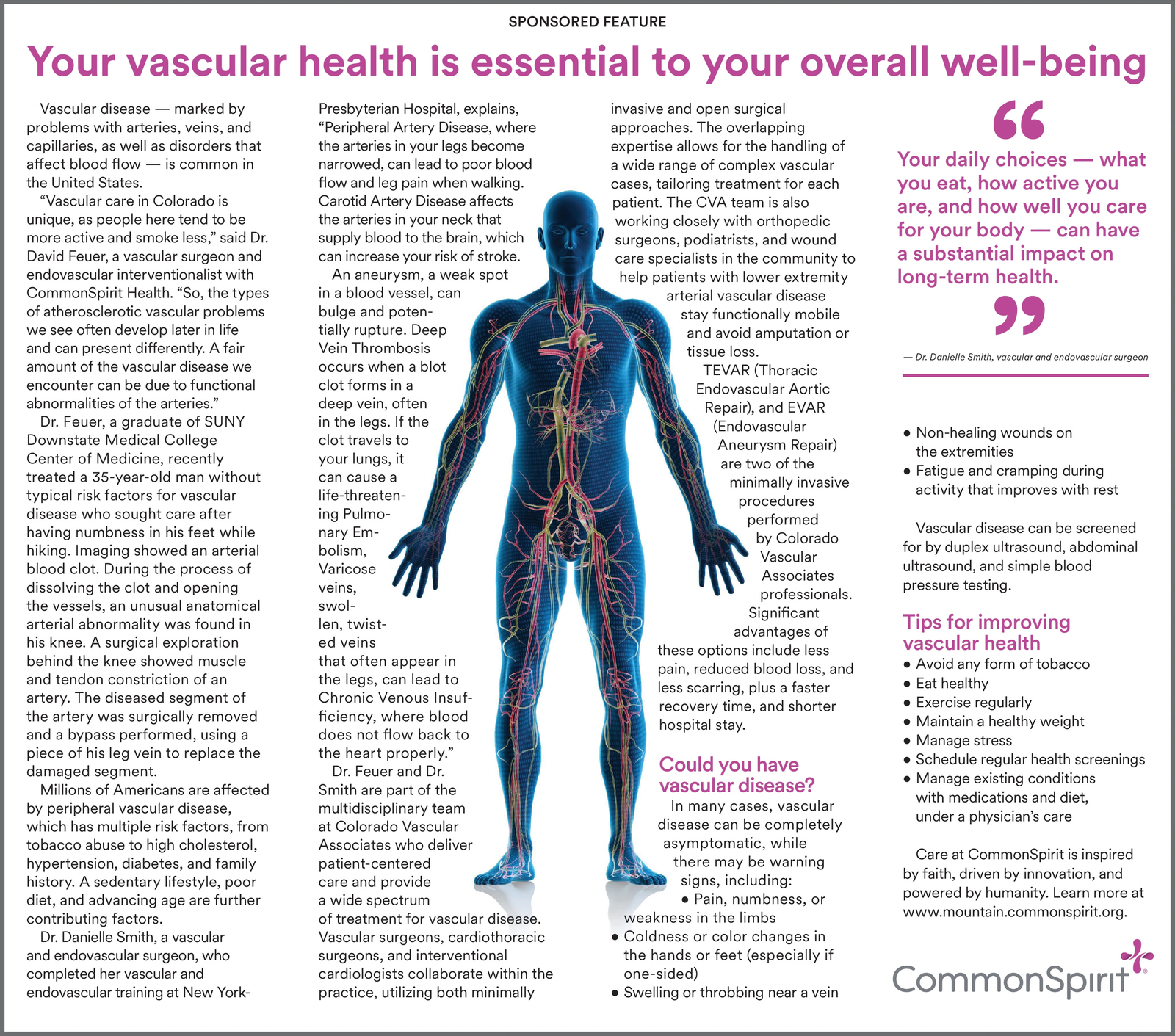Advertisement

-
Published Date
August 23, 2025This ad was originally published on this date and may contain an offer that is no longer valid. To learn more about this business and its most recent offers, click here.
Ad Text
SPONSORED FEATURE Your vascular health is essential to your overall well-being Vascular disease-marked by problems with arteries, veins, and capillaries, as well as disorders that affect blood flow is common in the United States. "Vascular care in Colorado is unique, as people here tend to be more active and smoke less," said Dr. David Feuer, a vascular surgeon and endovascular interventionalist with CommonSpirit Health. "So, the types of atherosclerotic vascular problems we see often develop later in life and can present differently. A fair amount of the vascular disease we encounter can be due to functional abnormalities of the arteries." Dr. Feuer, a graduate of SUNY Downstate Medical College Center of Medicine, recently treated a 35-year-old man without typical risk factors for vascular disease who sought care after having numbness in his feet while hiking. Imaging showed an arterial blood clot. During the process of dissolving the clot and opening the vessels, an unusual anatomical arterial abnormality was found in his knee. A surgical exploration behind the knee showed muscle and tendon constriction of an artery. The diseased segment of the artery was surgically removed and a bypass performed, using a piece of his leg vein to replace the damaged segment. Millions of Americans are affected by peripheral vascular disease, which has multiple risk factors, from tobacco abuse to high cholesterol, hypertension, diabetes, and family history. A sedentary lifestyle, poor diet, and advancing age are further contributing factors. Dr. Danielle Smith, a vascular and endovascular surgeon, who completed her vascular and endovascular training at New York- Presbyterian Hospital, explains, "Peripheral Artery Disease, where the arteries in your legs become narrowed, can lead to poor blood flow and leg pain when walking. Carotid Artery Disease affects the arteries in your neck that supply blood to the brain, which can increase your risk of stroke. An aneurysm, a weak spot in a blood vessel, can bulge and poten- tially rupture. Deep Vein Thrombosis occurs when a blot clot forms in a deep vein, often in the legs. If the clot travels to your lungs, it can cause a life-threaten- ing Pulmo- nary Em- bolism, Varicose veins, swol- len, twist- ed veins that often appear in the legs, can lead to Chronic Venous Insuf- ficiency, where blood does not flow back to the heart properly." Dr. Feuer and Dr. Smith are part of the multidisciplinary team at Colorado Vascular Associates who deliver patient-centered care and provide a wide spectrum of treatment for vascular disease. Vascular surgeons, cardiothoracic surgeons, and interventional cardiologists collaborate within the practice, utilizing both minimally invasive and open surgical approaches. The overlapping expertise allows for the handling of a wide range of complex vascular cases, tailoring treatment for each patient. The CVA team is also working closely with orthopedic surgeons, podiatrists, and wound care specialists in the community to help patients with lower extremity arterial vascular disease stay functionally mobile and avoid amputation or tissue loss. TEVAR (Thoracic Endovascular Aortic Repair), and EVAR (Endovascular Aneurysm Repair) are two of the minimally invasive procedures performed by Colorado Vascular Associates professionals. Significant advantages of these options include less pain, reduced blood loss, and less scarring, plus a faster recovery time, and shorter hospital stay. Could you have vascular disease? In many cases, vascular disease can be completely asymptomatic, while there may be warning signs, including: Pain, numbness, or weakness in the limbs Coldness or color changes in the hands or feet (especially if one-sided) Swelling or throbbing near a vein 66 Your daily choices - what you eat, how active you are, and how well you care for your body can have a substantial impact on long-term health. 9 -Dr. Danielle Smith, vascular and endovascular surgeon Non-healing wounds on the extremities Fatigue and cramping during activity that improves with rest Vascular disease can be screened for by duplex ultrasound, abdominal ultrasound, and simple blood pressure testing. Tips for improving vascular health Avoid any form of tobacco Eat healthy Exercise regularly Maintain a healthy weight Manage stress Schedule regular health screenings Manage existing conditions with medications and diet, under a physician's care Care at CommonSpirit is inspired by faith, driven by innovation, and powered by humanity. Learn more at www.mountain.commonspirit.org. CommonSpirit SPONSORED FEATURE Your vascular health is essential to your overall well - being Vascular disease - marked by problems with arteries , veins , and capillaries , as well as disorders that affect blood flow is common in the United States . " Vascular care in Colorado is unique , as people here tend to be more active and smoke less , " said Dr. David Feuer , a vascular surgeon and endovascular interventionalist with CommonSpirit Health . " So , the types of atherosclerotic vascular problems we see often develop later in life and can present differently . A fair amount of the vascular disease we encounter can be due to functional abnormalities of the arteries . " Dr. Feuer , a graduate of SUNY Downstate Medical College Center of Medicine , recently treated a 35 - year - old man without typical risk factors for vascular disease who sought care after having numbness in his feet while hiking . Imaging showed an arterial blood clot . During the process of dissolving the clot and opening the vessels , an unusual anatomical arterial abnormality was found in his knee . A surgical exploration behind the knee showed muscle and tendon constriction of an artery . The diseased segment of the artery was surgically removed and a bypass performed , using a piece of his leg vein to replace the damaged segment . Millions of Americans are affected by peripheral vascular disease , which has multiple risk factors , from tobacco abuse to high cholesterol , hypertension , diabetes , and family history . A sedentary lifestyle , poor diet , and advancing age are further contributing factors . Dr. Danielle Smith , a vascular and endovascular surgeon , who completed her vascular and endovascular training at New York- Presbyterian Hospital , explains , " Peripheral Artery Disease , where the arteries in your legs become narrowed , can lead to poor blood flow and leg pain when walking . Carotid Artery Disease affects the arteries in your neck that supply blood to the brain , which can increase your risk of stroke . An aneurysm , a weak spot in a blood vessel , can bulge and poten- tially rupture . Deep Vein Thrombosis occurs when a blot clot forms in a deep vein , often in the legs . If the clot travels to your lungs , it can cause a life - threaten- ing Pulmo- nary Em- bolism , Varicose veins , swol- len , twist- ed veins that often appear in the legs , can lead to Chronic Venous Insuf- ficiency , where blood does not flow back to the heart properly . " Dr. Feuer and Dr. Smith are part of the multidisciplinary team at Colorado Vascular Associates who deliver patient - centered care and provide a wide spectrum of treatment for vascular disease . Vascular surgeons , cardiothoracic surgeons , and interventional cardiologists collaborate within the practice , utilizing both minimally invasive and open surgical approaches . The overlapping expertise allows for the handling of a wide range of complex vascular cases , tailoring treatment for each patient . The CVA team is also working closely with orthopedic surgeons , podiatrists , and wound care specialists in the community to help patients with lower extremity arterial vascular disease stay functionally mobile and avoid amputation or tissue loss . TEVAR ( Thoracic Endovascular Aortic Repair ) , and EVAR ( Endovascular Aneurysm Repair ) are two of the minimally invasive procedures performed by Colorado Vascular Associates professionals . Significant advantages of these options include less pain , reduced blood loss , and less scarring , plus a faster recovery time , and shorter hospital stay . Could you have vascular disease ? In many cases , vascular disease can be completely asymptomatic , while there may be warning signs , including : Pain , numbness , or weakness in the limbs Coldness or color changes in the hands or feet ( especially if one - sided ) Swelling or throbbing near a vein 66 Your daily choices - what you eat , how active you are , and how well you care for your body can have a substantial impact on long - term health . 9 -Dr . Danielle Smith , vascular and endovascular surgeon Non - healing wounds on the extremities Fatigue and cramping during activity that improves with rest Vascular disease can be screened for by duplex ultrasound , abdominal ultrasound , and simple blood pressure testing . Tips for improving vascular health Avoid any form of tobacco Eat healthy Exercise regularly Maintain a healthy weight Manage stress Schedule regular health screenings Manage existing conditions with medications and diet , under a physician's care Care at CommonSpirit is inspired by faith , driven by innovation , and powered by humanity . Learn more at www.mountain.commonspirit.org . CommonSpirit
